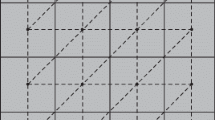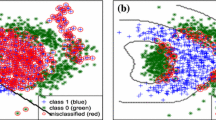Abstract
Machine learning has played an essential role in the past decades and has been in lockstep with the main advances in computer technology. Given the massive amount of data generated daily, there is a need for even faster and more effective machine learning algorithms that can provide updated models for real-time applications and on-demand tools. This paper presents FEMa—a finite element machine classifier—for supervised learning problems, where each training sample is the center of a basis function, and the whole training set is modeled as a probabilistic manifold for classification purposes. FEMa has its theoretical basis in the finite element method, which is widely used for numeral analysis in engineering problems. It is shown FEMa is parameterless and has a quadratic complexity for both training and classification phases when basis functions are used that satisfy certain properties. The proposed classifier yields very competitive results when compared to some state-of-the-art supervised pattern recognition techniques.






Similar content being viewed by others
References
Adeli H, Hung SL (1993) A concurrent adaptive conjugate gradient learning algorithm on MIMD machines. J Supercomput Appl 7:155–166
Adeli H, Hung SL (1994) An adaptive conjugate gradient learning algorithm for effective training of multilayer neural networks. Applied Mathematics and Computation 62:81–102
Adeli H, Hung SL (1994) Machine learning: neural networks, genetic algorithms, and fuzzy systems. Wiley, New York
Adeli H, Karim A (2000) Fuzzy-wavelet RBFNN model for freeway incident detection. J Transp Eng 126:464–471
Adeli H, Kumar S (1955) Distributed finite element analysis on a network of workstations---implementation and applications. J Struct Eng 121:1456–1462
Adeli H, Kumar S (1995) Distributed finite element analysis on a network of workstations—algorithms. J Struct Eng 121:1448–1455
Ahmadlou M, Adeli H (2010) Enhanced probabilistic neural network with local decision circles: a robust classifier. Integr Comput Aided Eng 17(3):197–210
Cha YJ, Choi W, Buyukozturk O (2017) Deep learning-based crack damage detection using convolutional neural networks. Comput Aided Civ Infrastruct Eng 32:361–378
Chou JS, Pham AD (2015) Smart artificial firefly colony-based support vector regression for enhanced forecasting in civil engineering. Comput Aided Civ Infrastruct Eng 30:715–732
Coppersmith D, Winograd S (1990) Matrix multiplication via arithmetic progressions. J Symb Comput 9:251–280
Cortes C, Vapnik V (1995) Support vector networks. Mach Learn 20:273–297
Dai H, Cao Z (2017) A wavelet support vector machine-based neural network metamodel for structural reliability assessment. Comput Aided Civ Infrastruct Eng 32(4):344–357
Guo L, Wang Z, Cabrerizo M, Adjouadi MA (2017) cross-correlated delay shift supervised learning method for spiking neurons with application to interictal spike detection in epilepsy. Int J Neural Syst 27:1750002
Hirschauer TJ, Adeli H, Buford JA (2015) Computer-aided diagnosis of Parkinson’s disease using enhanced probabilistic neural network. J Med Syst 39:1–12
Hung SL, Adeli H (1993) Parallel backpropagation learning algorithms on CRAY y-mp8/864 supercomputer. Neurocomputing 5:287–302
Karim A, Adeli H (2003) Comparison of the fuzzy - wavelet RBFNN freeway incident detection model with the california algorithm. J Transp Eng 128:21–30
Karim A, Adeli H (2003) Radial basis function neural network for work zone capacity and queue estimation. J Transp Eng 129:494–503
Khan S, Naseem I, Togneri R, Bennamoun M (2017) A novel adaptive kernel for the rbf neural networks. Circuits Syst Signal Process 36(4):1639–1653
Koziarski M, Cyganek B (2017) Image recognition with deep neural networks in presence of noise—dealing with and taking advantage of distortions. Integr Comput Aided Eng 24:337–350
LeCun Y, Bengio Y, Hinton GE (2015) Deep learning. Nature 521:436–444
Lehtinen J, Zwicker M, Turquin E, Kontkanen J, Durand F, Sillion F, Aila T (2008) A meshless hierarchical representation for light transport. ACM Trans Graph 17(37):1–9
Lin CM, Boldbaatar EA (2015) Autolanding control using recurrent wavelet Elman neural network. IEEE Trans Syst Man Cybern Syst 45:1281–1291
Lin CT, Prasad M, Saxena A (2015) An improved polynomial neural network classifier using real-coded genetic algorithm. IEEE Trans Syst Man Cybern Syst 45:1389–1401
Lin YZ, Nie ZH, Ma HW (2017) Structural damage detection with automatic feature-extraction through deep learning. Comput Aided Civ Infrastruct Eng 32:1025–1046
Liu P, Zeng Z, Wang J (2016) Multistability of recurrent neural networks with nonmonotonic activation functions and mixed time delays. IEEE Trans Syst Man Cybern Syst 46:512–523
Morabito FC, Campolo M, Mammone N, Versaci M, Franceschetti S, Tagliavini F, Sofia V, Fatuzzo D, Gambardella A, Labate A, Mumolia L, Tripodi GG, Gasparini S, Cianci V, Sueri C, Ferlazzo E, Aguglia U (2017) Deep learning representation from electroencephalography of early-stage Creutzfeld–Jakob disease and features for differentiation from rapidly progressive dementia. Int J Neural Syst 27:1650039
Nunes TM, Coelho ALV, Lima CAM, Papa JP, Albuquerque VHC (2014) EEG signal classification for epilepsy diagnosis via optimum path forest—a systematic assessment. Neurocomputing 136:103–123
Ortega-Zamorano F, Jerez JM, Gómez I, Franco L (2017) Layer multiplexing FPGA implementation for deep back-propagation learning. Integr Comput Aided Eng 24:171–185
Ortiz A, Munilla J, Gorriz JM, Ramirez J (2016) Ensembles of deep learning architectures for the early diagnosis of Alzheimer’s disease. Int J Neural Syst 27:1650025
Palomo EJ, Lopez-Rubio E (2016) Learning topologies with the growing neural forest. Int J Neural Syst 23:1650019
Papa JP, Falcão AX, Albuquerque VHC, Tavares JMRS (2012) Efficient supervised optimum-path forest classification for large datasets. Pattern Recognit 45(1):512–520
Papa JP, Falcão AX, Suzuki CTN (2009) Supervised pattern classification based on optimum-path forest. Int J Imaging Syst Technol 19(2):120–131
Papa JP, Fernandes SEN, Falcão AX (2017) Optimum-path forest based on k-connectivity: theory and applications. Pattern Recognit Lett 87:117–126
Pisani RJ, Nakamura RYM, Riedel PS, Zimback CRL, Falcao AX, Papa JP (2014) Toward satellite-based land cover classification through optimum-path forest. IEEE Trans Geosci Remote Sens 52(10):6075–6085
Rafiei MH, Adeli H (2016) A novel machine learning model for estimation of sale prices of real estate units. J Constr Eng Manag 42:04015066
Rafiei MH, Adeli H (2017) A novel machine learning based algorithm to detect damage in highrise building structures. Struct Des Tall Spec Build 26:e1400
Rafiei MH, Khushefati WH, Demirboga R, Adeli H (2017) Supervised deep restricted boltzmann machine for estimation of concrete compressive strength. ACI Mater J 114:237–244
Rocha LM, Cappabianco FAM, Falcão AX (2009) Data clustering as an optimum-path forest problem with applications in image analysis. Int J Imaging Syst Technol 19(2):50–68
Samworth RJ (2012) Optimal weighted nearest neighbour classifiers. Ann Stat 40:2733–2763
Sankari Z, Adeli H (2011) Probabilistic neural networks for diagnosis of Alzheimer’s disease using conventional and wavelet coherence. J Neurosci Methods 197:165–170
Shepard D (1968) A two-dimensional interpolation function for irregularly-spaced data. In: Proceedings of the 23rd ACM national conference. ACM Press, pp 517–524
Specht DF (1990) Probabilistic neural networks. Neural Netw 3:109–118
Wilcoxon F (1945) Individual comparisons by ranking methods. Biom Bull 1(6):80–83
Yu G, Adeli H (1993) Object-oriented finite element analysis using EER model. J Struct Eng 119:2763–2781
Zhang A, Wang KCP, Li B, Yang E, Dai X, Peng Y, Fei Y, Liu Y, Li JQ, Chen C (2017) Automated pixel-level pavement crack detection on 3d asphalt surfaces using a deep-learning network. Comput Aided Civ Infrastruct Eng 32:805–819
Acknowledgements
The authors would like to thank FAPESP Grants #2013/07375-0, #2014/16250-9, #2014/12236-1, and #2016/19403-6, FAPESP/OSU Grant #2015/50319-9, and CNPq Grants #306166/2014-3 and #307066/2017-7.
Author information
Authors and Affiliations
Corresponding author
Additional information
Publisher’s Note
Springer Nature remains neutral with regard to jurisdictional claims in published maps and institutional affiliations.
Rights and permissions
About this article
Cite this article
Pereira, D.R., Piteri, M.A., Souza, A.N. et al. FEMa: a finite element machine for fast learning. Neural Comput & Applic 32, 6393–6404 (2020). https://doi.org/10.1007/s00521-019-04146-4
Received:
Accepted:
Published:
Issue Date:
DOI: https://doi.org/10.1007/s00521-019-04146-4




